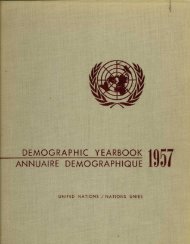Manual on Statistics of International Trade in Services
Manual on Statistics of International Trade in Services
Manual on Statistics of International Trade in Services
Create successful ePaper yourself
Turn your PDF publications into a flip-book with our unique Google optimized e-Paper software.
A. Introducti<strong>on</strong><br />
III. <strong>Services</strong> Transacti<strong>on</strong>s Between Residents and N<strong>on</strong>-residents<br />
3.1. The present chapter describes <strong>in</strong> detail the<br />
measurement <strong>of</strong> <strong>in</strong>ternati<strong>on</strong>al trade <strong>in</strong> services <strong>in</strong> the<br />
c<strong>on</strong>venti<strong>on</strong>al balance <strong>of</strong> payments sense <strong>of</strong> transacti<strong>on</strong>s<br />
between residents and n<strong>on</strong>-residents <strong>of</strong> an ec<strong>on</strong>omy. It<br />
sets out the pr<strong>in</strong>ciples underly<strong>in</strong>g the record<strong>in</strong>g <strong>of</strong> such<br />
trade. It discusses the c<strong>on</strong>cept <strong>of</strong> residence and its<br />
practical applicati<strong>on</strong>, valuati<strong>on</strong> <strong>of</strong> transacti<strong>on</strong>s, and other<br />
pr<strong>in</strong>ciples relat<strong>in</strong>g to record<strong>in</strong>g <strong>of</strong> transacti<strong>on</strong>s. It then<br />
describes the Extended Balance <strong>of</strong> Payments <strong>Services</strong><br />
Classificati<strong>on</strong>, the treatment <strong>of</strong> transacti<strong>on</strong>s between<br />
related parties, and the record<strong>in</strong>g <strong>of</strong> trade by trad<strong>in</strong>g<br />
partner. Allocati<strong>on</strong> by mode <strong>of</strong> supply is discussed, as is<br />
the treatment <strong>of</strong> repairs. F<strong>in</strong>ally, it describes each <strong>of</strong> the<br />
comp<strong>on</strong>ents <strong>of</strong> EBOPS. A further detailed elaborati<strong>on</strong> <strong>of</strong><br />
EBOPS comp<strong>on</strong>ents through the presentati<strong>on</strong> <strong>of</strong> a<br />
corresp<strong>on</strong>dence with CPC, Versi<strong>on</strong> 1.0 is set out <strong>in</strong><br />
annex III.<br />
B. Pr<strong>in</strong>ciples <strong>of</strong> record<strong>in</strong>g<br />
3.2. The pr<strong>in</strong>ciples for the measurement <strong>of</strong> services<br />
transacti<strong>on</strong>s between residents and n<strong>on</strong>-residents <strong>in</strong> the<br />
present <str<strong>on</strong>g>Manual</str<strong>on</strong>g> are the same as those prescribed <strong>in</strong><br />
BPM5 and the 1993 SNA. This is to ensure that<br />
compilers may make use <strong>of</strong> the same data sources as for<br />
compil<strong>in</strong>g balance <strong>of</strong> payments statistics and that<br />
statistics <strong>on</strong> <strong>in</strong>ternati<strong>on</strong>al trade <strong>in</strong> services are compiled<br />
<strong>on</strong> a basis c<strong>on</strong>sistent with that <strong>of</strong> other macroec<strong>on</strong>omic<br />
statistics. This is important both with<strong>in</strong> each country’s<br />
statistical system and also for purposes <strong>of</strong> <strong>in</strong>ternati<strong>on</strong>al<br />
comparability. The ma<strong>in</strong> pr<strong>in</strong>ciples for record<strong>in</strong>g these<br />
transacti<strong>on</strong>s are described below, and if more detailed<br />
guidance is needed, it may be obta<strong>in</strong>ed from BPM5 and<br />
its compani<strong>on</strong> volumes, the IMF Balance <strong>of</strong> Payments<br />
Textbook and the IMF Balance <strong>of</strong> Payments Compilati<strong>on</strong><br />
Guide. 38<br />
1. C<strong>on</strong>cept and def<strong>in</strong>iti<strong>on</strong> <strong>of</strong> residence<br />
3.3. The residence c<strong>on</strong>cept is central to the measurement<br />
<strong>of</strong> transacti<strong>on</strong>s between residents and n<strong>on</strong>-residents. The<br />
c<strong>on</strong>cept <strong>of</strong> residence <strong>in</strong> the present <str<strong>on</strong>g>Manual</str<strong>on</strong>g> is identical to<br />
38 Wash<strong>in</strong>gt<strong>on</strong>, D.C., 1996 and 1995, respectively.<br />
26<br />
that used <strong>in</strong> BPM5 and the 1993 SNA. It is not based <strong>on</strong><br />
nati<strong>on</strong>ality or legal criteria but <strong>on</strong> a transactor’s centre <strong>of</strong><br />
ec<strong>on</strong>omic <strong>in</strong>terest. Further, because territorial boundaries<br />
recognized for political purposes may not always be<br />
appropriate for ec<strong>on</strong>omic purposes, the ec<strong>on</strong>omic<br />
territory <strong>of</strong> a country is used as the relevant<br />
geographical area to which the c<strong>on</strong>cept <strong>of</strong> residence is<br />
applied. An <strong>in</strong>stituti<strong>on</strong>al unit is a resident unit <strong>of</strong> a<br />
country or ec<strong>on</strong>omy when it has a centre <strong>of</strong> ec<strong>on</strong>omic<br />
<strong>in</strong>terest <strong>in</strong> the ec<strong>on</strong>omic territory <strong>of</strong> a country.<br />
3.4. The ec<strong>on</strong>omic territory <strong>of</strong> a country c<strong>on</strong>sists <strong>of</strong> the<br />
geographic territory adm<strong>in</strong>istered by a government.<br />
Pers<strong>on</strong>s, goods and capital circulate freely with<strong>in</strong> this<br />
territory. Included are islands that bel<strong>on</strong>g to the country,<br />
airspace, territorial waters and the c<strong>on</strong>t<strong>in</strong>ental shelf ly<strong>in</strong>g<br />
<strong>in</strong> <strong>in</strong>ternati<strong>on</strong>al waters over which the country enjoys<br />
exclusive rights or over which it has, or claims to have,<br />
jurisdicti<strong>on</strong> <strong>in</strong> respect <strong>of</strong> the right to fish or to exploit<br />
fuels or m<strong>in</strong>erals below the seabed. Also <strong>in</strong>cluded are<br />
territorial enclaves, such as embassies, c<strong>on</strong>sulates,<br />
military bases, scientific stati<strong>on</strong>s, <strong>in</strong>formati<strong>on</strong> or<br />
immigrati<strong>on</strong> <strong>of</strong>fices and aid agencies, located <strong>in</strong> other<br />
ec<strong>on</strong>omies and used by the Government for diplomatic,<br />
military, scientific or other purposes, with the formal<br />
political agreement <strong>of</strong> the Governments <strong>of</strong> the<br />
ec<strong>on</strong>omies where these enclaves are physically located.<br />
Thus, while territorial enclaves used by foreign<br />
Governments (or <strong>in</strong>ternati<strong>on</strong>al organizati<strong>on</strong>s) may be<br />
located with<strong>in</strong> a country’s geographical boundaries, such<br />
enclaves are not <strong>in</strong>cluded <strong>in</strong> the host country’s ec<strong>on</strong>omic<br />
territory.<br />
3.5. An enterprise has a centre <strong>of</strong> ec<strong>on</strong>omic <strong>in</strong>terest, and<br />
thus residence, <strong>in</strong> an ec<strong>on</strong>omy when it engages and<br />
<strong>in</strong>tends to c<strong>on</strong>t<strong>in</strong>ue to engage <strong>in</strong> ec<strong>on</strong>omic activities <strong>on</strong> a<br />
significant scale either <strong>in</strong>def<strong>in</strong>itely or over a l<strong>on</strong>g period<br />
<strong>of</strong> time from <strong>on</strong>e or more locati<strong>on</strong>s, not necessarily<br />
fixed, with<strong>in</strong> the ec<strong>on</strong>omic territory <strong>of</strong> that ec<strong>on</strong>omy. A<br />
period <strong>of</strong> <strong>on</strong>e year is suggested as a guidel<strong>in</strong>e for<br />
determ<strong>in</strong><strong>in</strong>g residence, but this is not an <strong>in</strong>flexible rule.<br />
3.6. Producti<strong>on</strong> undertaken outside the ec<strong>on</strong>omic<br />
territory <strong>of</strong> a resident enterprise by the pers<strong>on</strong>nel, plant<br />
and equipment <strong>of</strong> that resident enterprise is treated as<br />
part <strong>of</strong> host country producti<strong>on</strong>, and the enterprise is<br />
treated as a resident unit (branch or subsidiary) <strong>of</strong> that

















